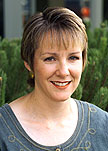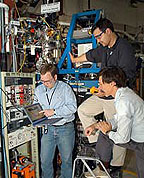| Research
|
|
|||||||||||||||||||||
|
PNNL, partners work In collaboration with U.S. industry and weapons centers in the former Soviet Union, DOE's Pacific Northwest National Laboratory is helping to reduce the risk of proliferation of weapons of mass destruction in Russia and neighboring countries. The alliance, under DOE's Initiatives for Proliferation Prevention (IPP) program, is coordinating the transformation of biological, chemical and nuclear weapons knowledge into efforts focused on peaceful, commercially viable products. The breakup of the Soviet Union in the early 1990s significantly destabilized the Russian economy, specifically leaving about 60,000 of the country's scientists and engineers without stable jobs. To prevent Russia's wealth of scientific expertise from getting into the wrong hands, the U.S. created the IPP in 1994 to help create stable, non-defense jobs for former weapons designers and scientists. Those experts' research knowledge will be used to create commercial products valuable to the former Soviet Union, Europe and U.S. markets. "The program's success lies in the fact that all parties get something out of it," says Ron Nesse, PNNL program manager for IPP. "U.S. businesses benefit from these scientists' knowledge of making novel and better products. On the other hand, those experts benefit from stable jobs, while the U.S. is assured there is less chance of transferring capabilities and knowledge to rogue countries." PNNL has a majority of all biological and chemical weapons projects within IPP. "Our researchers monitor proposals and projects to ensure each is scientifically sound and has commercial potential," Nesse says. "We also help connect commercial firms in the U.S. with weapons institutions in the former Soviet Union through a Cooperative Research And Development Agreement (CRADA)." The projects, funded by DOE, last two to three years. "The hope then is that the project becomes a commercial venture," Nesse says. The annual budget for IPP in FY 03 is approximately $23 million. PNNL oversees between $4 and $5 million of that total. "All of us working on the program feel there are many additional projects that are worth funding," says Nesse. With those IPP dollars, PNNL and its collaborators have achieved a number of successes, most notably the creation of unique humanized antibodies to gamma interferon, a protein that triggers and exacerbates various autoimmune conditions. A CRADA was recently signed by PNNL, Advanced Biotherapy Inc. of California, New Horizons Diagnostics Inc. of Maryland, and the Institute of Immunological Engineering of Moscow toward developing more effective treatments based on research by Russian scientists. "More than 50 million Americans suffer from autoimmune diseases such as rheumatoid arthritis and multiple sclerosis," says Dick Weller, project manager. "This project is a major step toward creating a much improved treatment for certain autoimmune diseases." Other IPP collaborative successes include testing microbes for remediation of oil contaminated fields; development of a plant growth stimulator that increases the growth rate of grasses and many broad-leaf plants by 40 percent; and creation of a quick and easy-to-use analyzer to identify neurotoxins that are harmful to human and animal health. "IPP is a very promising program to help create a more secure future for the world," Nesse says. "It's a quiet revolution that will help remake the world for the better." Submitted by DOE's Pacific Northwest National Laboratory |


